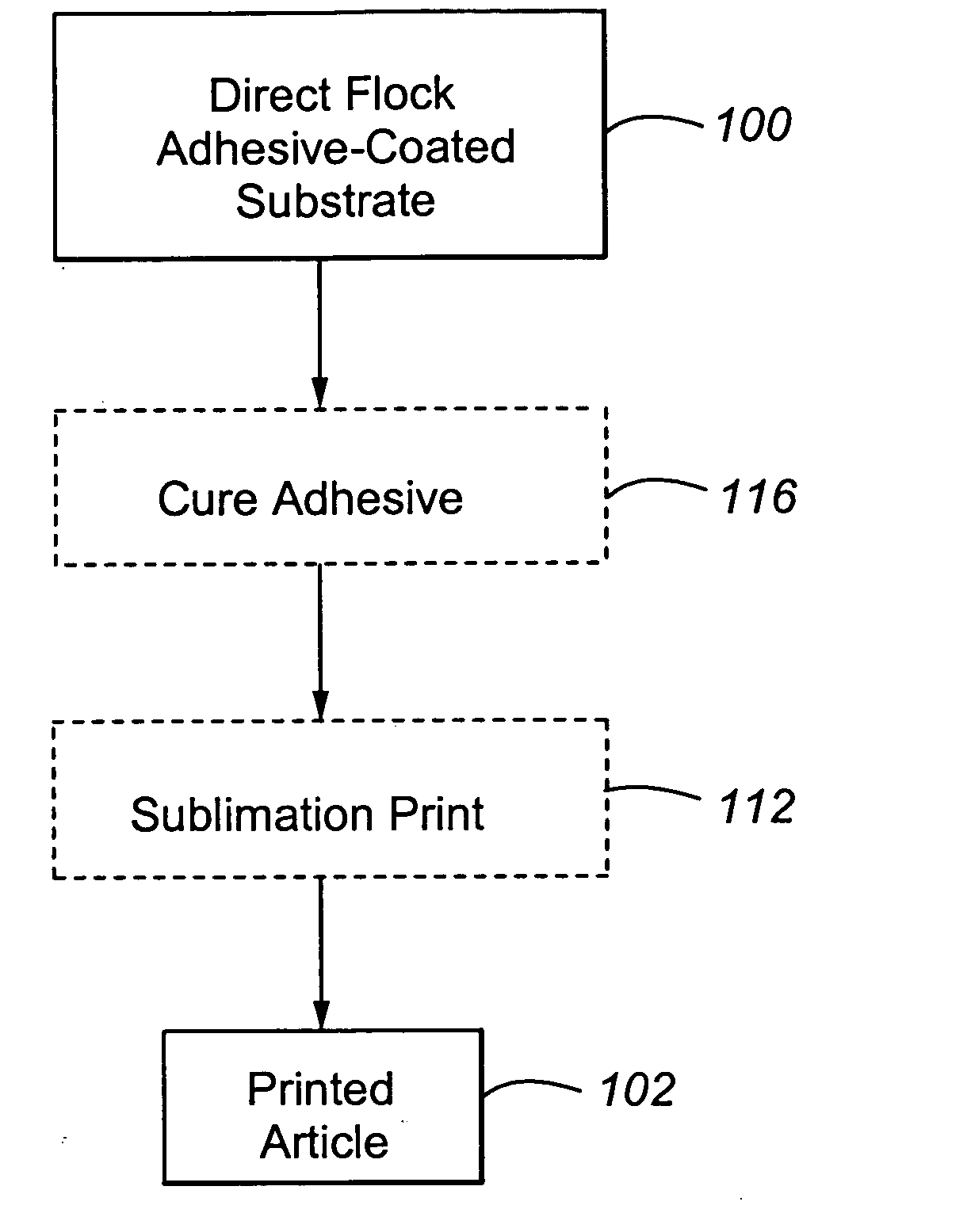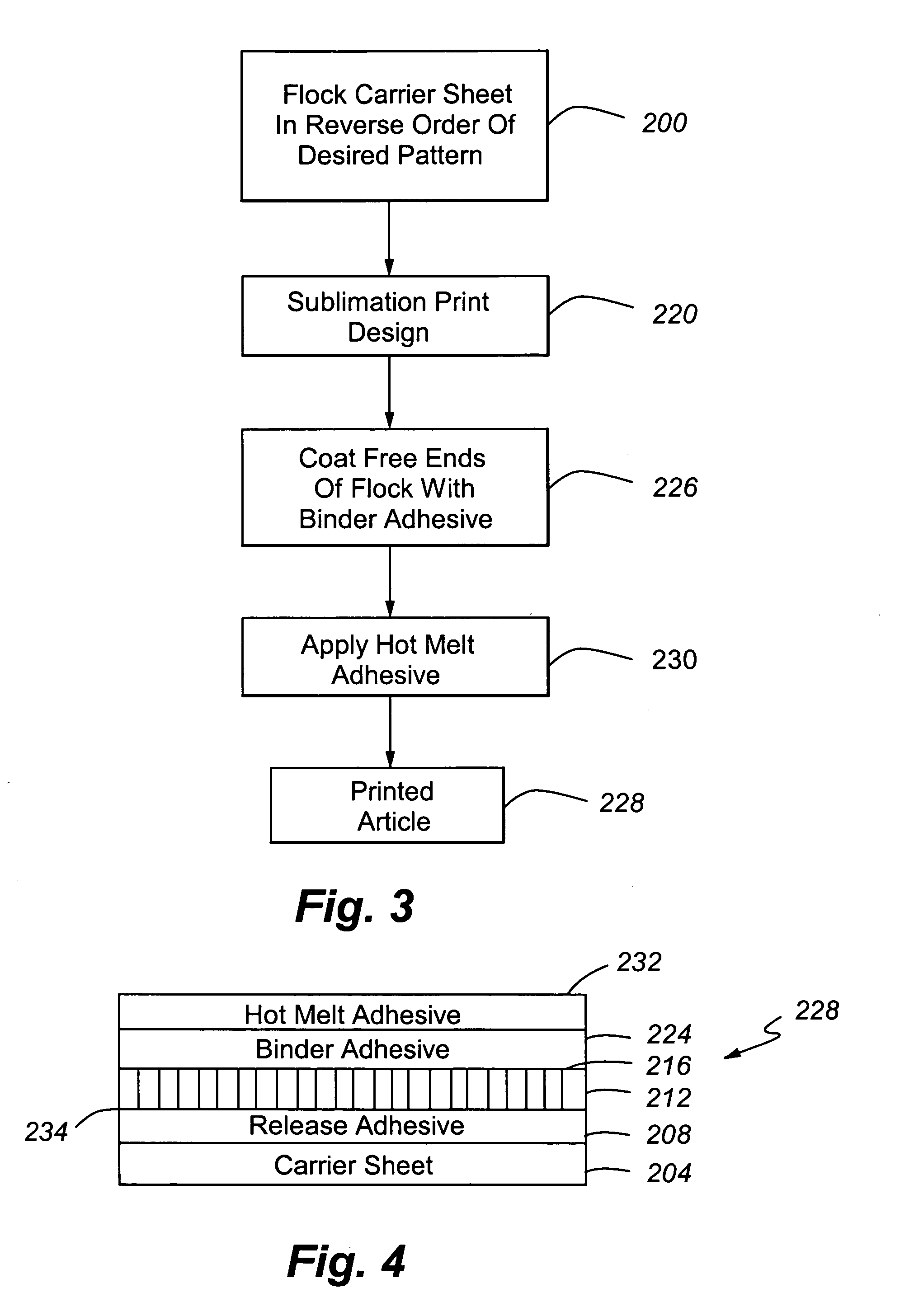Process for printing and molding a flocked article
a technology of flocked articles and moldings, applied in the direction of weaving, dyeing process, transportation and packaging, etc., can solve the problems of impracticality and cumbersome, and achieve the effect of reducing the cost of production, and improving the quality of production
- Summary
- Abstract
- Description
- Claims
- Application Information
AI Technical Summary
Benefits of technology
Problems solved by technology
Method used
Image
Examples
first embodiment
[0049] Referring to FIGS. 1 and 2, the process and article of the present invention will now be described. This process is further discussed in U.S. Provisional Application Ser. Nos. 60 / 366,580 filed Mar. 21, 2002; 60 / 393,362, filed Jul. 3, 2002; and 60 / 416,098 filed Oct. 4, 2002, each of which is incorporated herein by reference.
[0050] In the first step 100, an adhesive-coated substrate 104 is direct flocked by known techniques using the flock of the present invention. The flock is typically white in color and can be flocked by any suitable technique, with electrostatic flocking being preferred. The adhesive may be applied discontinuously to the substrate in a desired (direct) image.
[0051] The adhesive used in adhesive layer 108 may be any suitable permanent adhesive (as opposed to a release adhesive) that is thermally compatible with the sublimation printing temperature used in step 112. “Thermal compatibility” depends on the process configuration. When the adhesive is cured (e.g...
second embodiment
[0060] Referring to FIGS. 3 and 4, the process and article of the present invention will now be described. This process is further discussed in U.S. Pat. Nos. 4,810,549; 5,207,851; 5,597,637; 5,858,156; 6,010,764; 6,083,332; and 6,110,560, each of which is incorporated herein by this reference.
[0061] In step 200, the carrier sheet 204 containing a temporary release adhesive 208 (such as wax) in the reverse of the desired pattern or image is flocked by suitable techniques, preferably electrostatically, with the flock of the present invention.
[0062] The carrier sheet 204 can be any suitable transfer carrier, such as dimensionally stable paper, processed paper, plastic film, resin sheets, and metal foils. Depending on the desired effect and the sheet materials employed, the carrier can be transparent, translucent, or opaque, but is typically transparent. Typically (but not always), the primary carrier is a discontinuous sheet as opposed to a continuous sheet on a running web line.
[00...
third embodiment
[0068] Referring to FIGS. 5 and 6, the process and article of the present invention will now be described. This process is further discussed in U.S. patent Ser. Nos. 09 / 548,839; 09 / 35,721; and 09 / 621,830, each of which is incorporated herein by this reference. PCT-containing and bicomponent fibers are ideal fibers to withstand the temperature and pressure used in the lamination process in this configuration.
[0069] In step 500, the carrier sheet 504 containing a temporary release adhesive 508 (such as wax) in the reverse of the desired pattern or image is flocked by suitable techniques, preferably electrostatically, with the flock of the present invention.
[0070] The exposed ends 512 of the flocked surface 516 are then sublimation printed in step 520 by the techniques discussed previously. As noted, vacuuming of the flock can be conducted before or after sublimation printing.
[0071] The exposed, printed ends 512 of the flocked surface are next contacted with a first permanent adhesiv...
PUM
| Property | Measurement | Unit |
|---|---|---|
| Temperature | aaaaa | aaaaa |
| Fraction | aaaaa | aaaaa |
| Fraction | aaaaa | aaaaa |
Abstract
Description
Claims
Application Information
 Login to View More
Login to View More - R&D
- Intellectual Property
- Life Sciences
- Materials
- Tech Scout
- Unparalleled Data Quality
- Higher Quality Content
- 60% Fewer Hallucinations
Browse by: Latest US Patents, China's latest patents, Technical Efficacy Thesaurus, Application Domain, Technology Topic, Popular Technical Reports.
© 2025 PatSnap. All rights reserved.Legal|Privacy policy|Modern Slavery Act Transparency Statement|Sitemap|About US| Contact US: help@patsnap.com



